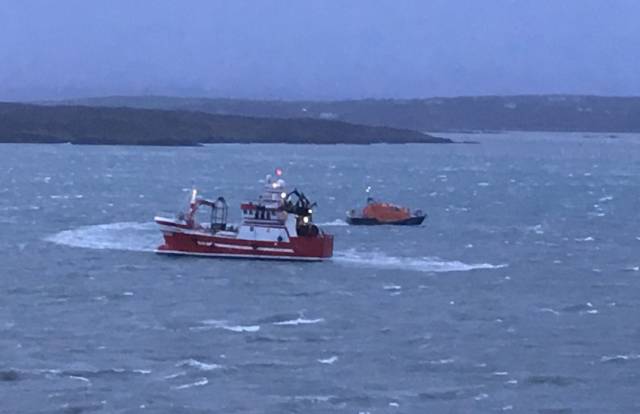Lifeboats in Baltimore and Portaferry were launched yesterday evening (Friday 26 April) as Storm Hannah swept over the island of Ireland.
Baltimore RNLI’s volunteer lifeboat crew launched their all-weather lifeboat at 8.30pm after learning of a local fishing trawler that was dragging its anchor in high winds near Sherkin Island in West Cork.
The lifeboat arrived on scene at 8.43pm and transferred four extra crew aboard the 26.2m trawler. Once they were satisfied that the casualty vessel was back at safe anchor, the lifeboat returned to station by 9.11pm as the storm intensified.
Conditions at sea during the callout were very rough, with Force 10 winds gusting to Force 11, and a two-metre sea swell within the harbour.
Elsewhere, the volunteer lifeboat crew from Portaferry RNLI launched to reports of a missing dingy with three people on board.
The lifeboat crew proceeded to Pig Island near Newtownards in Strangford Lough and were joined in the search by local coastguard and Rescue 119 from Preswick in Scotland.
However, all rescue teams were stood down after a thorough search of the area revealed nothing.
Commenting on the callout, Jordan Conway, Portaferry RNLI lifeboat press officer, said: “Despite the weather conditions deteriorating as the volunteer lifeboat crew reached the scene, a full search was carried out in conjunction with our colleagues in the coastguard and Rescue 119.”
As previously reported on Afloat.ie, Castletownbere RNLI also launched last night to a 33ft fishing vessel which lost all power in Bere Haven Harbour are the storm bore down.
While the severe weather has now passed, sea conditions will remain rough over the next few days, and Baltimore RNLI’s Kate Callanan urged anyone on or near the water to “exercise caution in particular along the coastline.
“If you get into trouble or see anyone in difficulty at sea or along the coast, call 999 or 112 and ask for the coastguard.”
































































